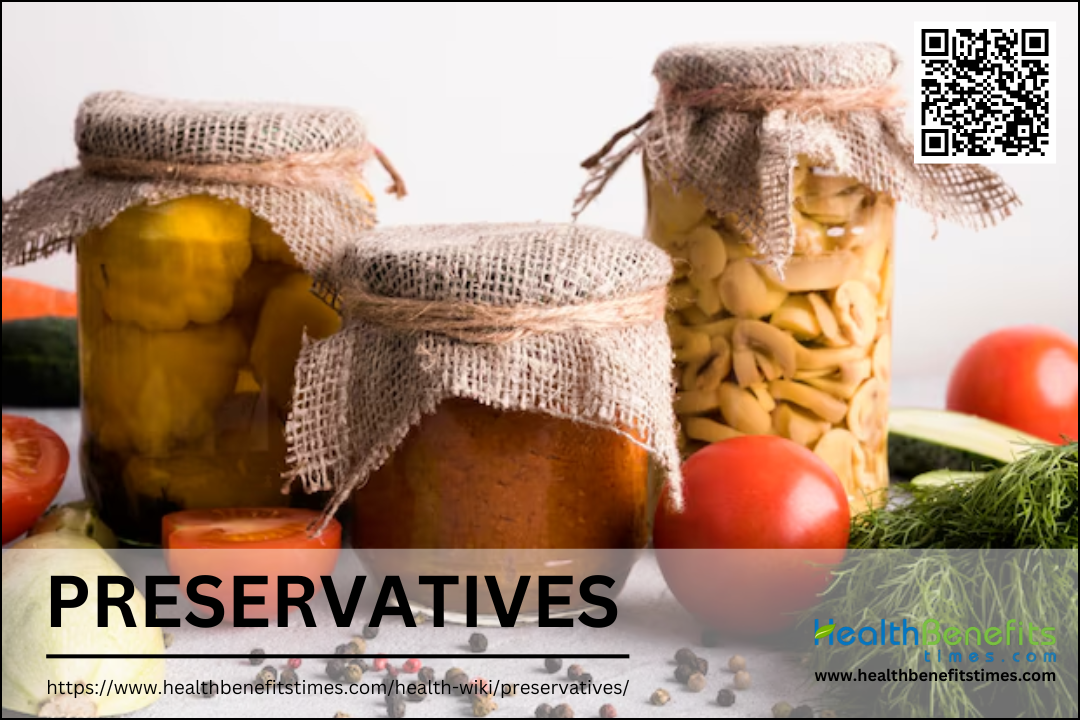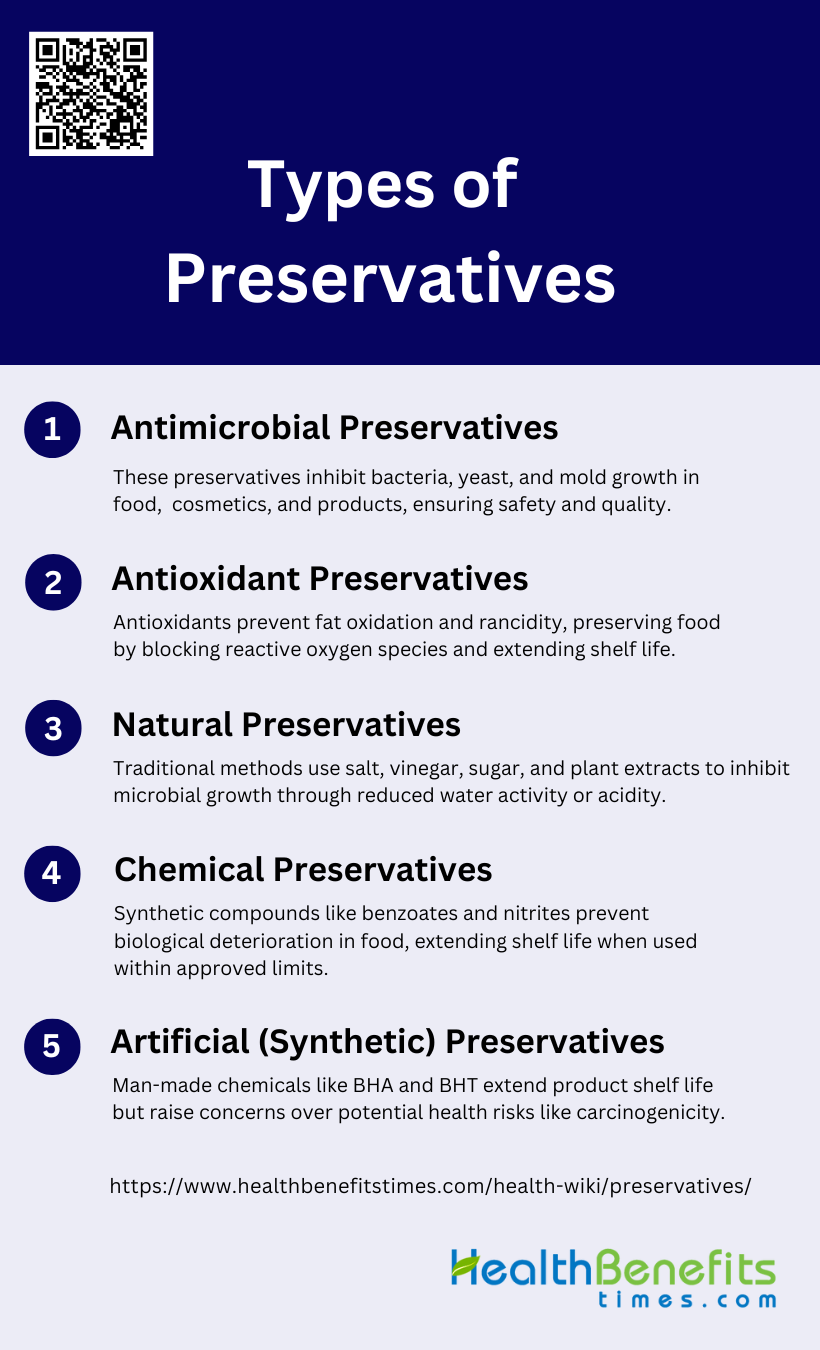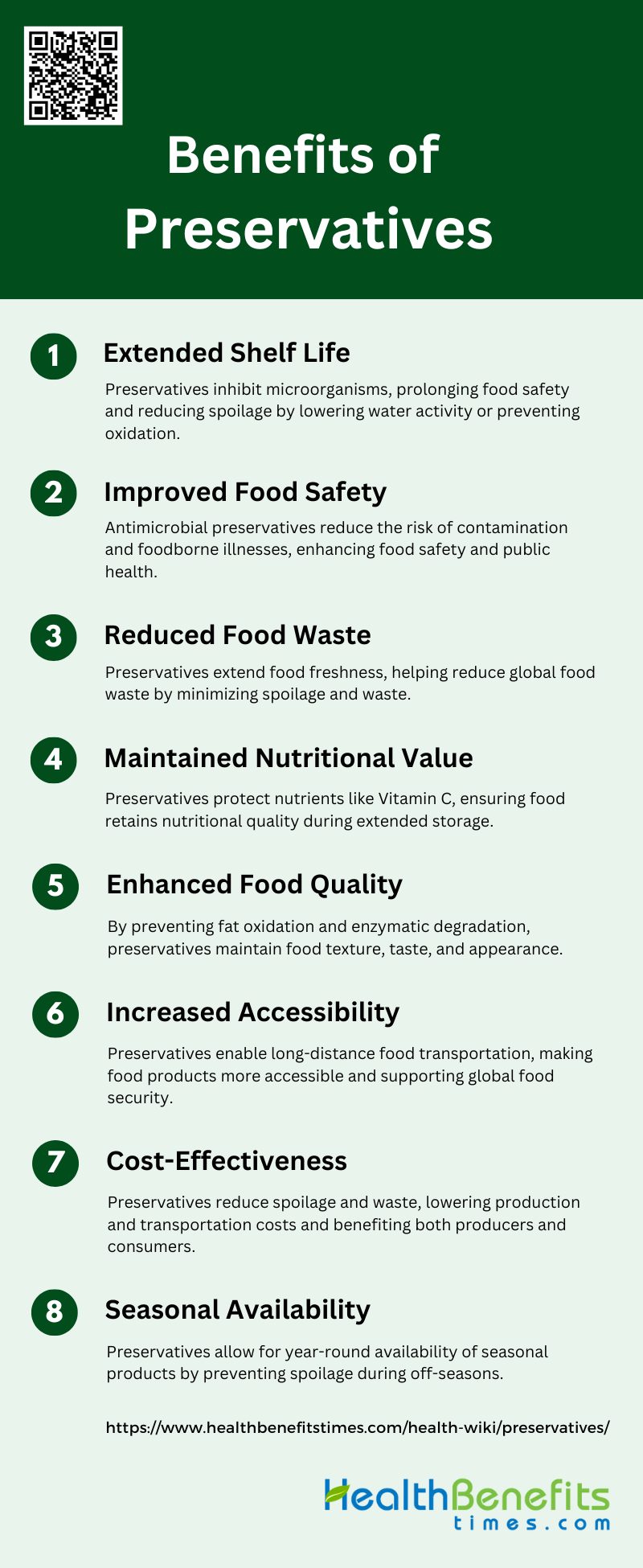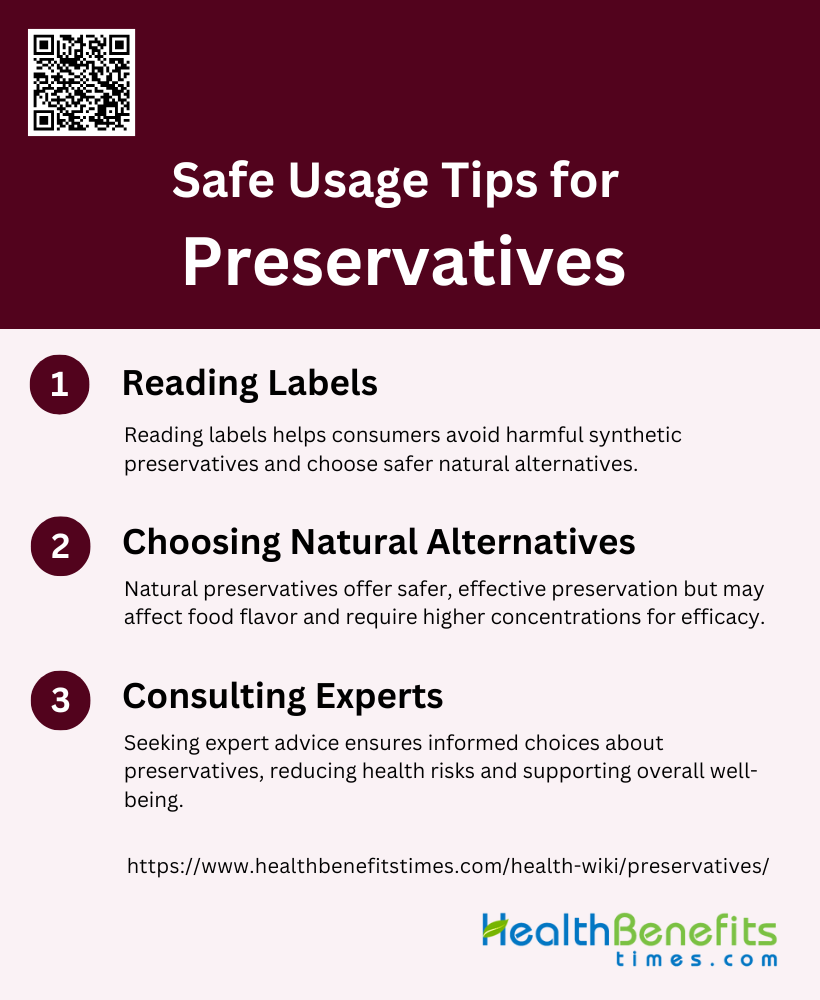Preservatives are substances added to food products to extend their shelf life and prevent spoilage caused by microorganisms, oxidation, or other chemical changes. These additives play a crucial role in maintaining food safety, quality, and freshness over extended periods. Preservatives can be natural or synthetic compounds that inhibit the growth of bacteria, molds, and yeasts, slow down enzymatic reactions, or prevent oxidation. Common preservatives include salt, sugar, vinegar, and artificial additives like sodium benzoate and potassium sorbate. While preservatives are essential for food safety and reducing food waste, there has been a growing consumer demand for “clean label” products with fewer artificial additives. This trend has led to increased research into natural preservatives and alternative food preservation methods to meet consumer preferences for healthier and more natural food options.
Types of Preservatives
Preservatives are essential in extending the shelf life of food products by preventing spoilage and maintaining quality. They can be categorized into various types based on their function and origin. Below is a list of the main types of preservatives used in the food industry:
1. Antimicrobial Preservatives
Antimicrobial preservatives are used to prevent the growth of bacteria, yeast, and mold in food, cosmetics, and other products. These preservatives ensure safety and avoid quality loss derived from microbial spoilage. Common examples include sorbic acid and sulfur dioxide, which are widely used due to their effectiveness in inhibiting microbial growth. Acidulants, organic acids, and parabens are also frequently employed for their antimicrobial properties.
2. Antioxidant Preservatives
Antioxidant preservatives prevent oxidation and spoilage of food by inhibiting the reactions that cause fats and oils to become rancid. These preservatives help in extending the shelf life and maintaining the quality of food products. Common examples include Vitamin E (tocopherols) and ascorbic acid, which are known for their ability to protect against the pathological effects of reactive oxygen species (ROS). Butylated hydroxyanisole (BHA) and butylated hydroxytoluene (BHT) are also widely used synthetic antioxidants.
3. Natural Preservatives
Natural preservatives have been used in traditional food preservation methods for centuries. Examples include salt, vinegar, sugar, and lemon juice, which preserve foods by reducing water activity or lowering pH to inhibit microbial growth. Plant extracts, essential oils, and spices such as basil, clove, neem, and rosemary are also effective natural preservatives due to their antimicrobial and antioxidant properties.
4. Chemical Preservatives
Chemical preservatives are synthetic substances used to control biological deterioration in foods. These include a wide variety of compounds such as benzoates, sorbates, parabens, organic acids, nisin, nitrites, and sulfites. They are commercially available and approved by regulatory agencies for use in foods, provided they are used within established maximum limits. These preservatives are essential for ensuring food safety and extending shelf life by preventing microbial growth and spoilage.
5. Artificial (Synthetic) Preservatives
Artificial or synthetic preservatives are man-made chemicals used to extend the shelf life of food, cosmetics, and pharmaceuticals. Common artificial preservatives include BHA, BHT, and sodium benzoate. These preservatives are manufactured through chemical processes and are used for their effectiveness in preventing spoilage and maintaining product quality. However, they have been associated with potential health risks such as hypersensitivity, allergies, and even carcinogenicity at high doses. Despite these concerns, they remain widely used due to their cost-effectiveness and long shelf life.
Common Uses of Preservatives
Preservatives are widely used across various industries to ensure the safety, efficacy, and longevity of products. They play a vital role in preventing spoilage and contamination. Below is a list of common uses of preservatives in different sectors:
1. Food Industry
Preservatives are essential in the food industry to ensure the safety and longevity of products. They help in prolonging shelf life and maintaining freshness by preventing spoilage caused by bacteria, mold, and other microorganisms. Common preservatives include acidulants, organic acids, and parabens, which act as antimicrobials and antioxidants to protect food from microbial, physical-chemical, or enzymatic reactions. Examples of preservative use can be seen in processed foods, canned goods, and baked products, where they help maintain quality and safety. There is a growing trend towards using natural alternatives like herbs, spices, and their derivatives due to consumer concerns about the health impacts of synthetic preservatives.
2. Cosmetic Industry
In the cosmetic industry, preservatives are crucial for preventing contamination and ensuring product safety during repeated use. Common preservatives include organic acids, alcohols, and phenols, which control the growth of bacteria, fungi, and molds. Despite their effectiveness, there is concern about the potential for preservatives to cause skin irritation or allergic reactions, leading to a demand for preservative-free or self-preserving cosmetics. Techniques like ‘Hurdle Technology‘ and the use of multifunctional antimicrobial ingredients and plant-derived essential oils are being explored as alternatives to traditional chemical preservatives.
3. Pharmaceuticals
Preservatives in pharmaceuticals are vital for maintaining drug efficacy and sterility, especially in medicines and vaccines. They prevent microbial contamination, which can compromise the safety and effectiveness of these products. Common preservatives in this sector include parabens, formaldehyde-releasers, and isothiazolinones, which are effective but can cause hypersensitivity and other adverse reactions. The industry is also exploring natural preservatives with antioxidant, antimicrobial, and anti-enzymatic properties to reduce the potential health risks associated with synthetic preservatives.
Benefits of Preservatives
Preservatives offer numerous advantages that contribute to the quality, safety, and availability of food products. They play a vital role in extending shelf life, reducing waste, and maintaining nutritional value. Below is a list of the key benefits of using preservatives:
1. Extended Shelf Life
Preservatives play a crucial role in extending the shelf life of food products by inhibiting the growth of microorganisms and delaying spoilage. This is achieved through various mechanisms, such as reducing water activity, lowering pH, and preventing oxidation. For instance, traditional preservatives like salt and sugar reduce water activity, making it difficult for bacteria to grow, while vinegar lowers the pH to create an inhospitable environment for microbial growth. By extending the shelf life, preservatives ensure that food remains safe and consumable for longer periods, reducing the frequency of food spoilage and waste.
2. Improved Food Safety
The use of preservatives significantly enhances food safety by preventing the growth of harmful bacteria, molds, and yeasts. Antimicrobial preservatives such as benzoic acid, nitrites, and sulphites are particularly effective in inhibiting microbial growth, thereby reducing the risk of foodborne illnesses. Additionally, antioxidants like BHA and BHT protect against the harmful effects of reactive oxygen species (ROS), which are associated with various diseases, including cancer and cardiovascular conditions. Thus, preservatives not only maintain the quality of food but also contribute to public health by minimizing the risk of contamination and disease.
3. Reduced Food Waste
By extending the shelf life and improving the safety of food products, preservatives play a vital role in reducing food waste. Foods that spoil quickly are more likely to be discarded, leading to significant waste. Preservatives help mitigate this issue by maintaining the freshness and edibility of food for longer periods, thereby reducing the amount of food that is thrown away. This is particularly important in a global context where food waste is a major concern, and efforts to reduce it can have significant environmental and economic benefits.
4. Maintained Nutritional Value
Preservatives can help maintain the nutritional value of food by preventing the degradation of essential nutrients. For example, sulphites are known to inhibit the browning of ascorbic acid (vitamin C), thereby preserving its nutritional content. Similarly, phosphates used in food processing have antimicrobial properties that help maintain the nutritional quality of food by preventing spoilage. However, it is important to note that some preservatives can have adverse effects on certain nutrients, and their impact should be carefully evaluated to ensure that the overall nutritional value of the food is preserved.
5. Enhanced Food Quality
Preservatives contribute to the enhancement of food quality by maintaining its taste, texture, and appearance. Antioxidants, for instance, prevent the oxidation of fats and oils, which can lead to rancidity and off-flavors. Anti-enzymatic preservatives like citric acid block enzymatic processes that can degrade food quality even after harvest. By preserving the sensory attributes of food, preservatives ensure that consumers receive products that are not only safe but also enjoyable to eat, thereby enhancing the overall food experience.
6. Increased Accessibility
The use of preservatives allows for the distribution of food products over long distances and extended periods, making them more accessible to a wider population. This is particularly important for processed foods that need to be transported across continents. By preventing spoilage during transportation and storage, preservatives ensure that food remains available and affordable in regions where fresh produce may not be readily accessible. This increased accessibility helps in meeting the dietary needs of diverse populations and supports global food security.
7. Cost-Effectiveness
Preservatives contribute to the cost-effectiveness of food production and distribution by reducing spoilage and waste. By extending the shelf life of food products, preservatives minimize the losses incurred due to spoilage, thereby lowering the overall cost of food production. Additionally, the ability to transport and store food for longer periods without spoilage reduces the need for frequent restocking and transportation, further cutting down costs. This cost-effectiveness benefits both producers and consumers, making food more affordable and accessible.
8. Seasonal Availability
Preservatives enable the availability of seasonal foods throughout the year by preventing spoilage and maintaining their quality during off-seasons. This is particularly beneficial for perishable items like fruits and vegetables, which can be preserved and consumed long after their harvest season. By using preservatives, food producers can ensure a steady supply of seasonal products, providing consumers with a diverse range of food options regardless of the time of year. This not only enhances dietary variety but also supports the agricultural industry by stabilizing demand and supply.
Risks and Concerns of Preservatives
While preservatives offer numerous benefits, they also come with certain risks and concerns that need to be addressed. These concerns range from potential health issues to regulatory and safety considerations. Below is a list of the primary risks and concerns associated with preservatives:
1. Health Concerns
Synthetic preservatives, such as nitrates, nitrites, and sulfites, have been linked to various health issues, including headaches, allergies, asthma, gastrointestinal disorders, and potential carcinogenic effects. These concerns have led to increased consumer demand for natural preservatives, which are perceived as safer alternatives. However, even natural preservatives can influence food sensory properties and may have their own safety considerations when used in large amounts.
2. Regulation and Safety
Food safety authorities like the FDA and EFSA regulate the use of preservatives to ensure they are safe for consumption. These regulations include setting maximum allowable levels for various preservatives to minimize health risks. Adhering to these safe levels is crucial to prevent adverse health effects, and ongoing research and policy updates are necessary to address emerging safety concerns and ensure consumer protection.
3. Long-term Effects
Long-term consumption of synthetic preservatives has raised concerns about chronic health conditions, including cancer, cardiovascular diseases, and neurological damage. Research indicates that some preservatives, like nitrites, can form carcinogenic compounds, while others may disrupt gut microbiota or cause allergic reactions over time. These potential long-term effects underscore the importance of continued research and monitoring to fully understand the implications of prolonged exposure to synthetic preservatives.
Preservative-Free and Natural Alternatives
Increasing Demand for Preservative-Free Products
The demand for preservative-free products has surged as consumers become increasingly health-conscious and wary of synthetic additives. This trend is particularly evident in the food industry, where there is a growing preference for natural and minimally processed foods. Consumers are seeking products that are free from artificial preservatives due to concerns about potential health risks associated with synthetic chemicals. This shift in consumer behavior has prompted the food industry to explore and adopt natural alternatives to meet these demands while ensuring food safety and quality. The challenge lies in balancing consumer preferences with the need to maintain product shelf life and safety.
Natural Alternatives to Synthetic Preservatives
Natural alternatives to synthetic preservatives have gained significant attention as safer and healthier options for extending the shelf life of food products. These alternatives include plant extracts, essential oils, chitosan, bacteriocins, and other bioactive compounds with antimicrobial and antioxidant properties. For instance, essential oils and chitosan have been effectively used in edible coatings and packaging to preserve fish and seafood. Similarly, plant-based polyphenol-rich extracts have shown potent antimicrobial activities, making them valuable for food preservation. The development of natural preservatives not only addresses consumer concerns but also offers additional health benefits, making them a promising solution for the food industry.
Challenges of Going Preservative-Free
Transitioning to preservative-free products presents several challenges, primarily related to reduced shelf life and product stability. Natural preservatives, while effective, often have limitations in terms of stability, cost-effectiveness, and sensory impacts on food products. For example, natural preservatives may alter the flavor, color, and texture of foods, which can affect consumer acceptance. Additionally, the effectiveness of natural preservatives can vary depending on the food matrix and storage conditions, making it difficult to achieve consistent results. To overcome these challenges, innovative solutions such as combining different natural preservatives or using advanced packaging technologies are being explored to enhance the shelf life and stability of preservative-free products.
Safe Usage Tips for Preservatives
Using preservatives safely is essential to ensure the quality and safety of food products. By following certain guidelines, consumers can make informed choices and minimize potential risks. Below are some tips for the safe usage of preservatives:
1. Reading Labels
Reading labels is crucial for safe usage of preservatives. Ingredient lists provide essential information about the types and amounts of preservatives used in food products. Consumers should be aware of common synthetic preservatives such as nitrites, nitrates, benzoates, and sulfur dioxide, which are often linked to health risks like allergies, asthma, and even cancer. By understanding these labels, consumers can make informed choices and avoid potentially harmful additives. Additionally, recognizing natural preservatives like salt, sugar, vinegar, and essential oils can help consumers opt for safer alternatives that maintain food quality without adverse health effects.
2. Choosing Natural Alternatives
Natural preservatives offer a safer alternative to synthetic additives, with benefits such as antioxidant and antimicrobial properties that help extend the shelf life of food products. For instance, essential oils and plant extracts are effective in inhibiting microbial growth and preventing oxidation. However, there are some drawbacks. Natural preservatives can sometimes alter the sensory properties of food, such as flavor and texture, which may not be acceptable to all consumers. Additionally, the effectiveness of natural preservatives can vary, and they may require higher concentrations or combinations with other methods to achieve the desired preservation effect.
3. Consulting Experts
Consulting experts like nutritionists and healthcare providers is essential for making informed decisions about the use of preservatives. These professionals can provide personalized advice based on individual health needs and dietary preferences. They can help identify safe and effective natural preservatives and recommend strategies to minimize exposure to harmful synthetic additives. Experts can also guide consumers on how to read labels and choose products that align with their health goals. By seeking professional advice, consumers can ensure they are making choices that support their overall well-being and reduce the risk of adverse health effects from preservatives.
FAQs
1. How do preservatives affect people with food allergies or sensitivities?
Some preservatives, both natural and synthetic, may trigger allergic reactions in sensitive individuals. For instance, sulfites can cause breathing issues in people with asthma. It’s essential to read labels carefully and avoid preservatives known to trigger allergies.
2. Are there any preservatives that are banned or restricted in certain countries?
Yes, different countries have varying regulations regarding preservatives. For example, certain artificial preservatives like BHA and BHT are restricted in the EU but allowed in the U.S. due to differing safety assessments.
3. How can I tell if a product contains natural or synthetic preservatives?
You can identify the type of preservatives used in a product by reading the ingredient list. Natural preservatives include items like salt, vinegar, and essential oils, while synthetic ones often have chemical names like sodium benzoate or BHT.
4. Can preservatives affect the flavor or texture of food?
Yes, some preservatives, particularly natural ones like vinegar or salt, can alter the flavor of food. In some cases, synthetic preservatives may also slightly impact taste or texture, but food manufacturers aim to minimize such changes.
5. Do preservatives break down over time or remain in the body?
Most preservatives break down through digestion and are either metabolized or excreted by the body. However, concerns exist over certain synthetic preservatives potentially accumulating or causing long-term health effects if consumed regularly in large amounts.
6. Are there any preservatives specifically designed for use in organic food?
Yes, organic standards permit certain natural preservatives like ascorbic acid (vitamin C), citric acid, and tocopherols. These are typically used to meet the “organic” label requirements while extending shelf life naturally.
7. How do preservatives in cosmetics compare to those in food?
Preservatives in cosmetics, such as parabens and formaldehyde releasers, are primarily used to prevent microbial contamination rather than spoilage. These substances are formulated differently, though concerns over skin sensitivities and health risks from synthetic preservatives apply to both food and cosmetic products.
8. Are there any health benefits associated with natural preservatives?
In addition to their antimicrobial properties, natural preservatives like rosemary extract and essential oils may offer antioxidant benefits, potentially contributing to overall health when consumed in food.
9. Can food without preservatives be stored for long periods?
Without preservatives, food generally has a shorter shelf life and must be consumed quickly or stored under specific conditions (like freezing or vacuum-sealing) to prevent spoilage.
10. Are preservatives safe for children and pregnant women?
Most preservatives are considered safe within regulatory limits; however, some, like nitrates and nitrites, should be consumed in moderation, particularly by children and pregnant women, due to potential health risks.





